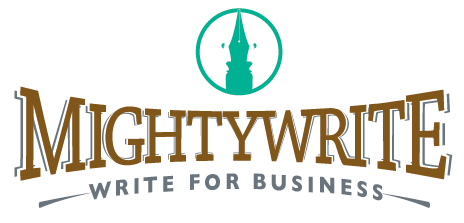MightyWrite’s lead Leanne Fournier is a writer through and through. In addition to business writing, Leanne has expanded her craft to fiction, non-fiction and poetry. She is currently working on a poetry collection she plans to self-publish in 2025, and a novel that is in early stages.
“A refuge” was part of an online exhibit at The Muse/Douglas Family Art Centre. Leanne painstakingly used an old form of typography – letraset to lovingly hand render each word. You can see the full exhibit here.
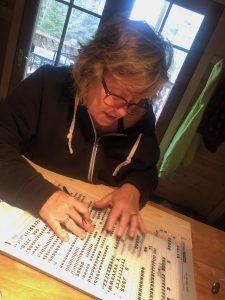
A refuge
I step outside, inhale deeply, my foot slips
these are the days we need to move cautiously.
Foolish me, thinking the threats of the long winter have passed,
the sun in the sky laughs at our clumsiness as we trip toward its warm embrace.
My pup tears ahead,
shaggy coat dragging through the mud,
pebbles cling when he rolls in the dust.
We are all ungroomed in isolation,
pale shadows of our socialized selves
desperately lifting our faces
awakening to the new season
like the grey jays boldly feeding.
Like us, they were here through it all,
the mid-season mess is a temporary doorway
through the darkness of our quarantine.
Wind brushes over me sweeping the shadows away
the feeling of new grass
the garden’s rich deep earth
the greenhouse, a refuge.
Inside now, my steps are firmer,
it’s early in this season,
I make a fire and lean into its comfort.
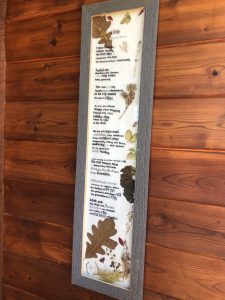
More works…
Tourist town
The visitor’s eyes cast ahead
scanning the known, the concealed,
outcrops of grey granite, silver pine,
endless waters, proud islands
subtle pathways chartered by sun or moon.
The outsider doesn’t look back
or return the gaze of abandoned souls,
drowning in the artificial calm
of the wake they leave behind.
No excuses
Unsuccessful entry to CBC non-fiction contest, 2021.
The brown icy water has found its way to the surface of the sprawling, frozen river. Unusual during this time of year. Late February 2021, and we are still in the depths of the long cold winter.
Its appearance is like an admonishment, a warning that perhaps we shouldn’t step beyond the shoreline where we know we are safe – closing off the river trails that have been a reprieve through the endless days of pandemic isolation. Perhaps it isn’t safe to go out yet.
It doesn’t take much to incite fear for those of us who are always afraid.
‘Dammit’ I think, but my attempts to be brave, to face a multitude of fears, are tinged with relief when circumstances – in this case the commanding forces of Mother Nature – let me off the hook.
As the days pass and the temperatures once again dip lower, a look out of frosted windows tells a different story. My excuses are drowned by the deepening ice that is safe again for footfalls, skis and prevalent winter motorized vehicles.
These final intruders skid past, delighting in the return of their playground. While it’s an activity considered safe in these COVID times, my own peace is broken by their presence. Yet, their safe passage through the narrow creek and out onto the bay and then the river, is the message I need to take in what is happening in front of me.
There are no more excuses.
There are so many things to be afraid of both physically and mentally, aren’t there? A catastrophic pandemic has had a dulling effect for people like me who are afraid of most things. We are now all afraid – even those who are fearless.
I’ve made it outside, my resolve to shake off the latest cramps of quarantine firm as I bend down to tighten the straps on my snowshoes. I grasp my poles and step one foot in front of the other, emerging from the forest that is my front yard and descending down the steep, slippery shoreline. The brittle snow crunches underfoot as I step cautiously onto the frozen river.
My eyes sweep the expanse of riddled pathways forged by the snowbound traffic and I begin to walk, poles out in front stabbing the ice surface, checking for air pockets. I’ve had more than one boot full this way.
One foot in front of the other. A few cracks in the surface reveal how the water found its way up from the insulating depths of ice and snow.
A light snowfall provides a soft reprieve for the bay, concealing some tracks and revealing others.
I pause as I see large, clear paw prints. Timber wolf, recognizable because they are flattened and spread out like snow shoes. Clever top predators. It’s surprising that there is only the one set because we had listened to a pack, howling in symphony late into the night, their cries carried over our bay by the cascading glow of the full moon.
The freshness of these prints show that this lone ranger may have forgotten he or she is supposed to be nocturnal. My yorkie poodle scurries ahead, his mottled, unkept fur trailing along the ice, picking up chunks of snow. Like him, we are all ungroomed in isolation.
I wonder as I approach the outcrop that marks the end of our bay and the beginning of the river if I’ll spot a kill, the reason for the midnight sonata.
The unending expanse of the long river ice unfolds and I see nothing untoward. No indecipherable chunks of remains or blood spread out under the freshly fallen snow. It’s white and sparkling in the cold mid-day sun. I pull my balaclava up over my face. Gusts of north wind brush over me, sweeping the morning shadows away. Wide awake, I plod along, hastening my steps to increase my heart rate. At the same time, I scour the snow covered heaps of granite shoreline for any sign of movement.
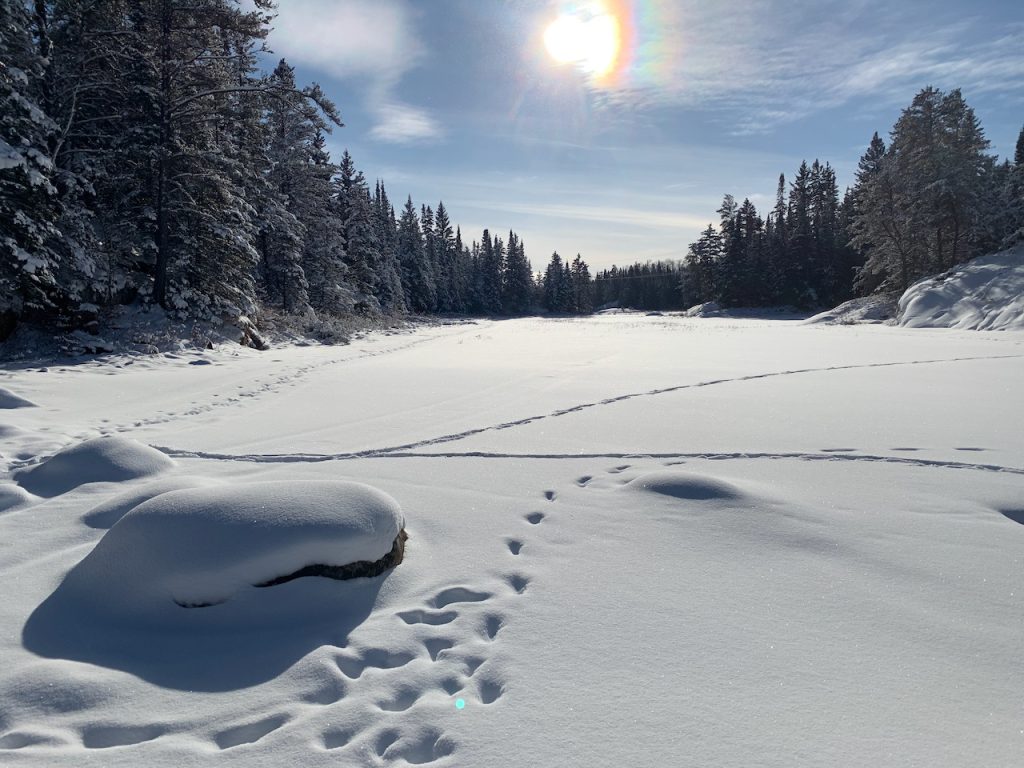
It is rare to see wolves during the day, but all of the neighbours in our secluded inlet have at one time or another, usually a scraggly wanderer that appears to be lost or confused as the rest of its pack is fast asleep after a night of hunting, mating and other antics of life in the wild. Perhaps they are tired of isolation too.
Comforted that I am indeed alone, I heave myself up one of the gentler shoreline inclines leading into my favourite trail through the dense forest. It’s too narrow for anything other than two or four leggeds. I take it to escape the drone of snow machines I can hear in the distance and know will be racing by in a short while, their fumes and souped up motors an affront to the solitude.
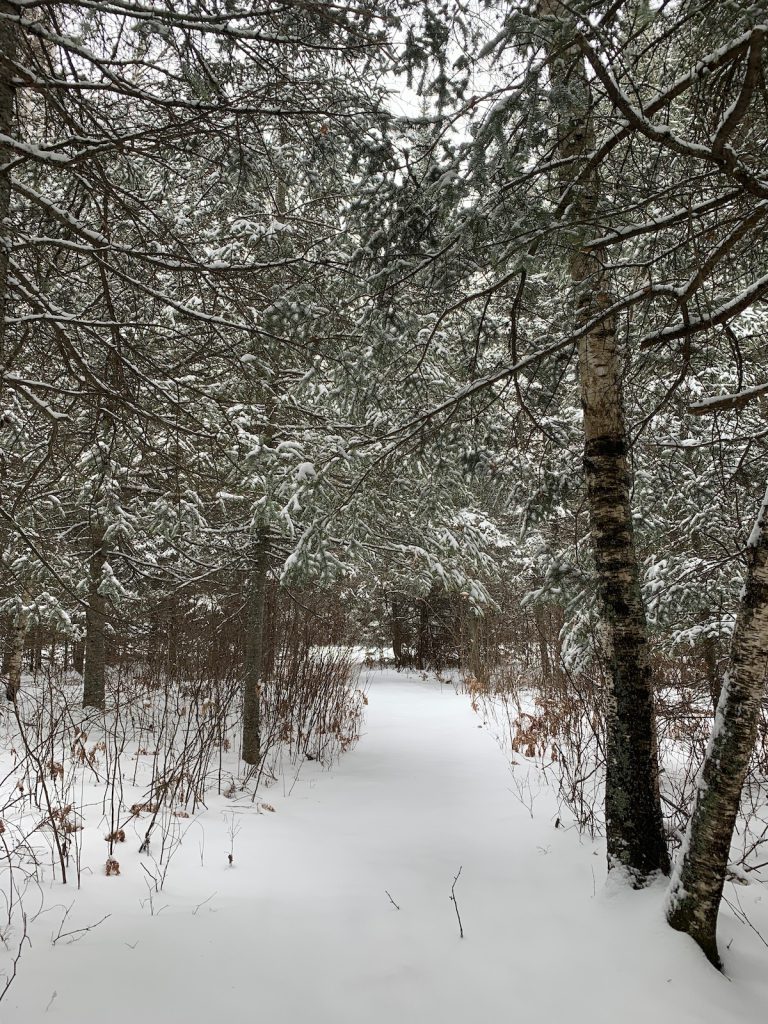
The sun peeks through towering pines, balsam, and spruce, growing brighter where there are stands of tall, barren birch and poplar. As I trudge along, my thoughts wander aimlessly, but I’m aware of the cold crisp air as I take in deep breaths. I’m winded, a reminder that I’ve been a little too complacent in isolation.
A sudden rustle startles me. I stop, stand perfectly still and curse myself for forgetting the whistle I usually carry during bear season. At least it might scare something away or alert my partner, Mike, that I need his help.
My other hand hovers over my cell phone in my breast pocket, as if that’s any help. The Yorkie also stops, his ears perked. I grab his collar as he moves to dart off into the forest in the direction of the threatening disturbance. He’s fast but small in comparison to our large lab, gone for a year now, who always charged fearlessly, clearing the way ahead during our hikes.
I see it out of the corner of my eye, a flash of movement just past a massive fallen poplar tree. It’s white, and I’m reminded of the story one of our old neighbours shared about seeing a lone white wolf. I brace myself but I know that there are very few stories of wolves attacking humans in these parts. We tend to skirt around each other, seeing faint shadows just after the sun has settled into twilight, but only from a distance.
A large rabbit scurries onto the path in front of me, flaunting it’s speed and I think having a good laugh at my expense. She’s a remarkable size, clearly well-fed, the lower snowfall making it easier for her to fatten up. I now see the telltale sprinkling of rabbit poo along the path and a band of other smaller paw prints alongside her sizeable ones. She must have a family nearby.
I walk more softly, happy to see her sprint ahead and then disappear under another fallen tree and off into the deeper forest. She too has survived the threats that are always nearby.
The clearing emerges that marks the end of the trail and where sadly, a large strip of Hydro lines have decimated much of the habitat and forest. They cast an ominous disturbance to what should be a bounty of coniferous trees and untended brush, wildflowers and berries.
But such are the needs of humans and while I deplore this interruption, I accept it. I like my electricity too. Especially in isolation.
I continue through the long expanse of trail cut by a snow machine that must have passed through recently. The snowshoeing would be a lot harder through here without this help. I duck my head, focusing on the forest that borders either side of the Hydro invasion. At the final rise, before I’ll descend back onto the river, I see it. It was what I was looking for all along. The scrappy evidence of the wolves who gathered in harmony the night before. There is no kill but the snow reveals faint imprints of varying sizes, mounds of snow and brushed out sections where they must have rested, tousled, or did whatever wolves do when they come together.
These most social of animals, bound by the hierarchal responsibilities of their packs and families seem explicitly beautiful at this particular moment. I am jealous as I lick my wounds of loss, unsure of my role as a leader and participant in my own flock that has been cast adrift for so many months now.
I take a deep breath and turn toward the river to make my way home. Another day of solitude awaits, broken only by the rousing roar of snow machines scooting through the frozen creek alongside our property that will melt soon. But for now, it’s a signal that we aren’t completely alone.
I hasten my steps to get out of the way as I too walk, one foot in front of the other, along that same narrow creek.
I’m no match for the power of these other inhabitants.
I reach for the hoe
I reach for hoe, like I reach for prayer.
By all appearances, it’s a small thing this getting up early and heading out into the garden. But not really. During COVID and isolation, the garden has literally taken a life of its own (apologies if that’s cliche). And in doing it has saved mine.
It isn’t just a simple thing. We are luckier than most in our isolation with plenty of space to more around outside and in, far enough away from “civilization” to avoid the threats of infection but close enough to have access to most things we need.
My partner Mike was consumed early last spring to get the greenhouse finished. It’s a hilarious structure constructed of wood, windows, shelves and an array of other bits and pieces we cobbled together from our “maybe we’ll use someday” pile. The clear polypropylene roof is pretty much all that’s new. The timing was perfect as it was ready to start using just as a global pandemic shut us all in. Now, I had a place – thanks to a couple of space heaters – where I could go to escape my desk, computer and the confines of our small cabin turned home.
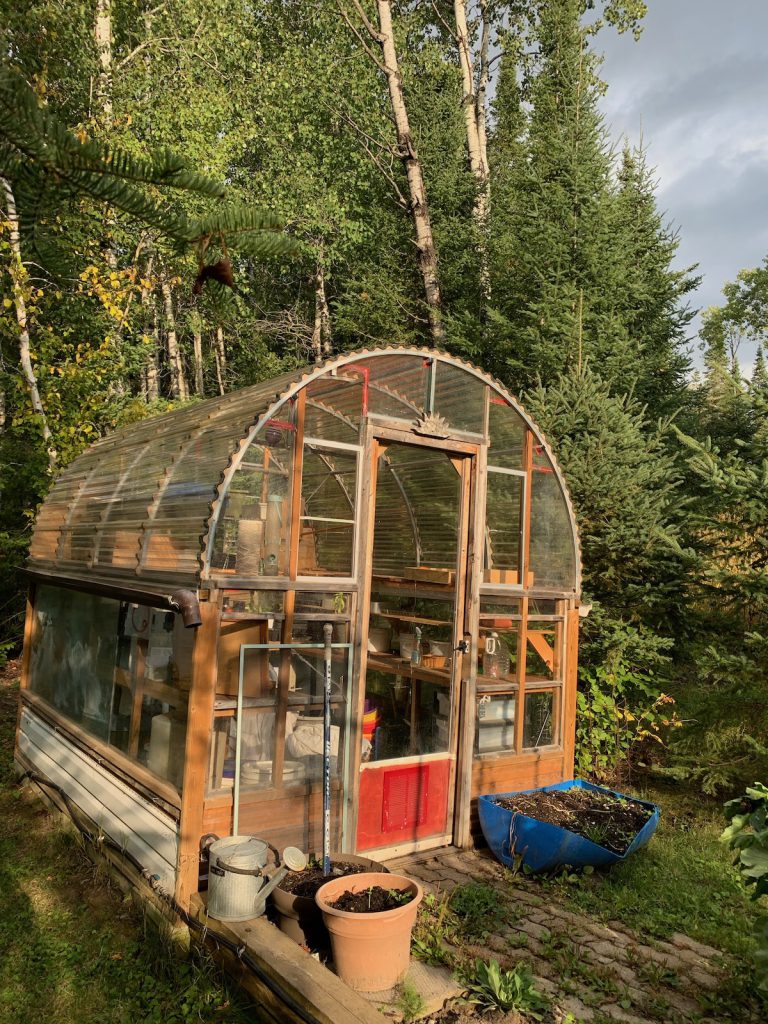
It was actually only ready later in spring, I think early May, so the seedlings had all been started in the small enclosed area under our building, where they shared space with our water heater, freezer and compost toilet. Mike had contrived a hanging shelf for the seedlings as I’d lost them all to mice the previous year. Everything had a great start by the time I was able to move the established plants – which mice are apparently less interested in – into the new old greenhouse.
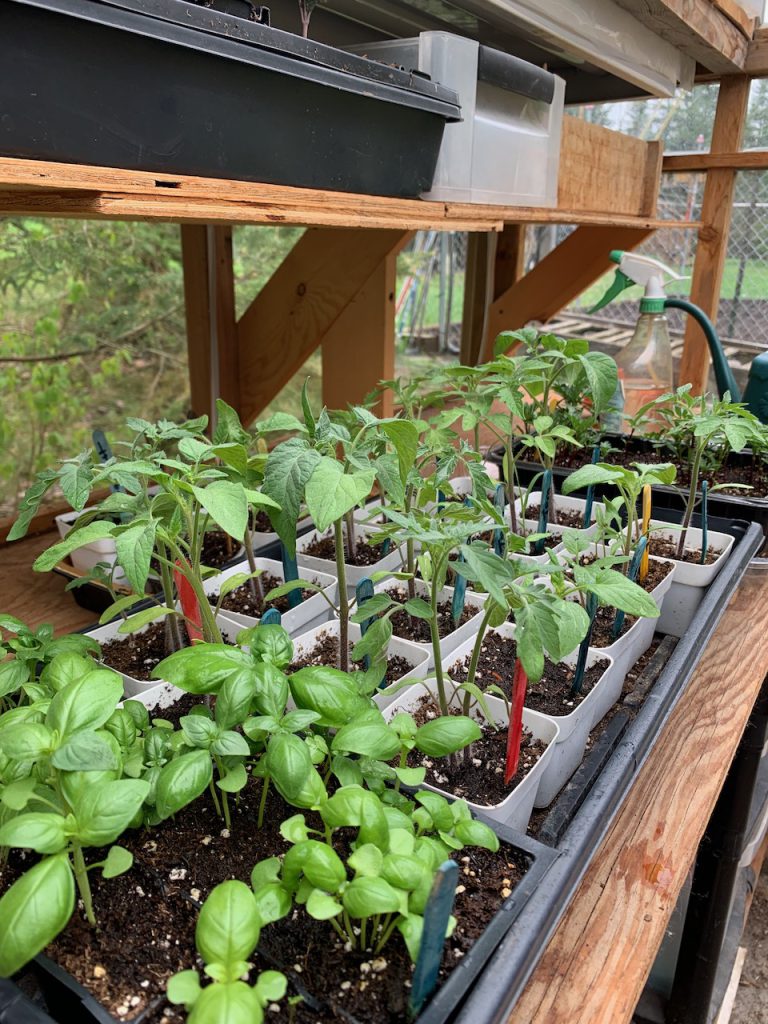
I didn’t expect everything to take like it did but lo and behold, I ended up having 42 tomato plants for my garden. I was stubbornly devoted to planting ALL of them along with potatoes, peas, beans, beets and carrots.
The elder gardeners all warned me against this but every one of the seedlings felt like a child to me as COVID kept my other living “offspring” away. I was determined to make it work.
The result was a less than stellar tomato crop – tons of tomatoes but few ripened before the threat of frost so were picked and moved into the greenhouse to ripen, with varying results. I mastered recipes for fried green tomatoes but frankly, those would kill me and my husband if eaten too often! I spent a lot of time experimenting with canning but didn’t get as much as I’d hoped to share with the family – salsa, relish, stewed tomatoes. I must say, my salsa was especially kick-ass. Because there wasn’t much, I was especially selective in who got some!
I knew that come next year, I’d need to have a better plan.
Who knew we would still be in full isolation a year later?
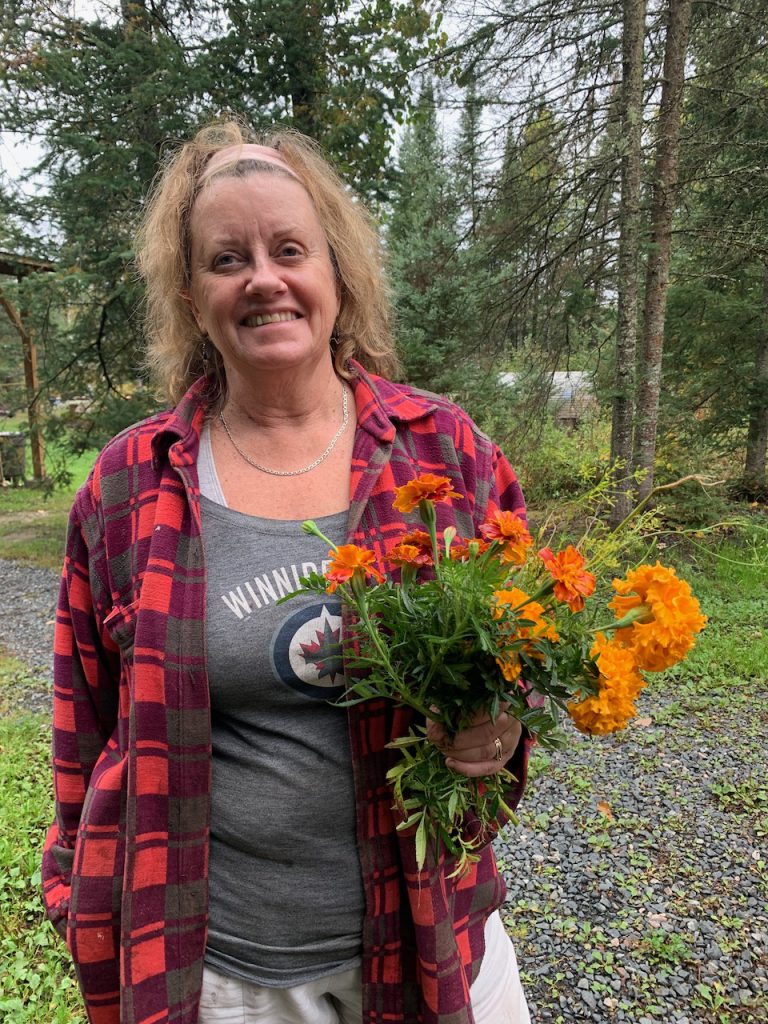
Possibility
The pieces of things that fall where they will
landing on the strings of time
scattered through days, months, years,
like loose threads seeking pattern
for their intended purpose
or unintended, like mail delivered to the wrong address
then made right in the meeting
that should have happened years before
or not, for all the reasons, the lessons, the losses,
it would not have worked out anyhow.
We pick up strands, try to stitch them together
filaments drop from our fingers and disappear
into another possibility
they may find us again
happenstance, unexpected, who knew
that invitation would have so many strings attached.
Chronicles
Some stories don’t have happy endings,
abandoned like an onion skin,
layers peeled away
and returned to the elements.
Reasons for the desertion are not clear,
no evidence of why it was forsaken
when there was so much to lose.
The creaking of old floorboards,
massive ceilings now under foot
hoard the stories carried up
into the highest beams.
They were so large, the stories.
The stone hearth stands still and tall
alone in the demise
like one of the deserters
unbending against the solid granite
from where it all began.
The foundation of what had been built impenetrable,
who would have thought it would end this way?
The water washes up on the sand beach shore
as it always has,
the invitation as evocative
as it was all that time ago
when dangers were denied,
conclusion unforeseen.
Worry
Walks through the forest, fragrant boughs,
you need to duck and brush away
for fear they’ll scratch or mark you
like all the worries
you carry with you
wherever you go.
Take a different path,
head toward the sun that peeks through taller branches
too high to hurt.
A trail opens along the rocky shoreline,
you are nervous about slipping in
down where the thinning ice separates from shore.
Footing is restored, leading to a surer way
the mossy green tundra to the left beckons,
less threatening, greener, more alive.
Look ahead, see what’s there, an opening
wringing hands can rest against the giants,
oak or red pine.
Lean into it, feel the strength it gives
even when it is threatened like you,
like everything does.
A clearing emerges, steps can be taken without fear,
the way unencumbered by barriers
wild beings are still a concern
but uneasiness has taken a rest
in the grace of birds beckoning overhead.
For now, agitation is quieted by the fescue
crunching with firmness underfoot, crackle in the bush a warning to be alert
you decide to not be afraid
but still, you step aside,
returning to where you belong.
